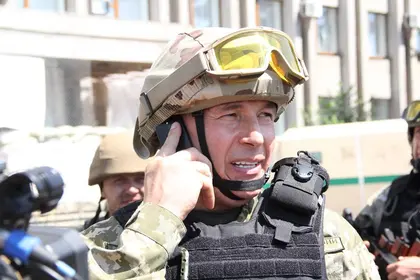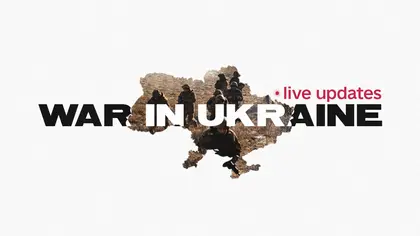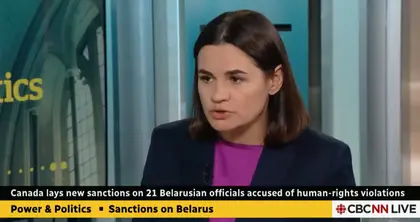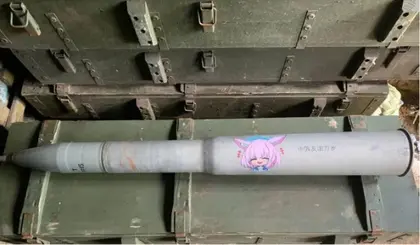Speaking on July
6 at a military base in Izium, some 50 kilometers north of Sloviansk, Heletey
said a sense of normality was being restored to the city that had served as the
focal point of the armed conflict since it broke out almost three months ago.
“When we entered Sloviansk there were a lot of people waiting for us who
were tortured by hunger, tortured by the lack of water,” he said.
The government said it was starting to restore infrastructure in the city, including water and electricity supply, as of today. The president’s press service said Ukrainian flags were also flying over Artemivsk and Druzhkivka as government troops recaptured those cities on July 6.
Heletey said people in the east of Ukraine have suffered from Russian propaganda also.
“They had been fooled by the ideological war that has been waged,
professionally, by the Russian special services. [It] has made them very
suspicious about the army, about those people that will today be protecting
them,” Heletey said, adding that the president will provide all necessary
assistance to all recaptured cities in Donetsk and Luhansk regions.
He denied media claims
that the Ukrainian army had allowed separatist fighters to escape Sloviansk
during the operation to liberate the city.
“This is
disinformation. The main column of militants which moved from the city of Sloviansk to the city
of Kramatorsk was stopped. The armed forces destroyed heavy machinery, a great
number of tanks, APCs and other machines. Over 30 terrorists were killed. You
can go and see for yourself, and either confirm or refute my words,” he said.
Heletey also spoke
of shifting dynamics in the standoff between Ukrainian army and pro-Russian
forces, commenting on growing reports of separatist fighters retreating from
other towns and settlements once firmly under their control.
“We have information that [rebel forces] are leaving their bases en
masse. Yesterday in the city of Sloviansk you saw a whole heap [of weapons] – three
fully loaded KAMAZ trucks could not take all the arms that the terrorists had.
In the same manner they left weapons in Kramatorsk and other cities,” he added.
In a July 6 interview with Russian media following the rebel forces’ defeat, separatist commander Igor Girkin (also known as Igor Strelkov) admitted that many rebel fighters had died defending the city, although “between 80 percent and 90 percent of our men and arms were transported out of the town.” He gave no exact figures concerning the death toll.
The recapture of Sloviansk has been hailed by President Petro Poroshenko
as a “turning point” in the conflict, and the news has dominated the Ukrainian-
and Russian-language blogospheres.
One Facebook post from July 6 compares the appearance of the town hall
in Sloviansk two days ago with the Presidential Palace in Grozny, Chechnya’s capital, following
its liberation by the Russian army in May 2000. Included below is the caption
“feel the difference”.

The new Defense
Minister said the ATO will continue until all of eastern Ukraine is freed from separatists. It resumed on July 1 following Poroshenko’s announcement of an end
to the government-imposed ceasefire.
“The special operation to clear cities of terrorists will continue in
this way: the armed forces will continue the ATO; after they clear up the city,
the residential area, Interior Ministry troops along with the National Guard
and the SBU will engage to recommence the work of the local power organs,” he
said.
When asked how long he expects the conflict to continue, Heletey
declined to make specific prognoses while emphasizing the importance of public
support in stemming the flow of violence.
“I don’t like to give predictions. But if people receive and support the
Ukrainian army and the forces engaged in the ATO it will not go on for long… The people are disoriented and afraid of Ukraine, of Kyiv. They are
afraid they will be punished and tortured. The residents have to… first and foremost not support, passively or
actively, those terrorists. If it works this way, the process will be very
quick,” he said.
He promised a renewed effort to swiftly conclude the government’s campaign
to reassert authority in rebel-controlled areas.
“We will not stop. We will bring in maximum numbers of troops and weapons,
and strengthen them with National Guard soldiers, police troops and the
Security Service – all will be thrown in to defend the Donbas… to defend those
cities from terrorists,” he said.
“Those not willing to give up arms [will] understand that waging a war
against the Ukrainian army and the Ukrainian people is not just dangerous but
it will mean doom for these people… We will continue the active phase
until the moment there is not a single terrorist left on the territory of
Donetsk and Lugansk,” Heletey concluded.
The statement
was Heletey’s first public appearance since his appointment on July 3 by
President Petro Poroshenko. The former police officer immediately made a name
for himself with a short address to parliament, in which he promised to regain
Crimea following its annexation by Russia in March.
“There will be a
victory parade… In Ukraine’s Sevastopol,” he said.
However, insurgent leader Girkin said he would
attempt in the next few days to coordinate the actions of insurgent troops in
Luhansk and Donetsk, and vowed not to give up the fight against the Ukrainian army.
“We will continue fighting, and try not to make the same mistakes we’ve
made in the past… Those who think the population will be saved by us giving
up without a fight – no, it won’t be. Those advancing towards us are the true
fascists in the sense of the word that our predecessors had used – hellhounds,
murderers, bandits, marauders… Real scum,” Girkin said.
In the meantime, images have surfaced of columns of separatist fighters
and artillery entering Donetsk, with fears the two regional capitals of Donetsk
and Luhansk are set to become the next flashpoints in a conflict that has
already claimed over 450 lives since tensions escalated in mid-April.
ATO’s press center said fighting was starting in Luhansk by Sunday evening, while in Donetsk there were massive numbers of armed people roaming the streets.
Kyiv Post staff writer Matthew Luxmoore can be reached at [email protected] and on Twitter at @mjluxmoore.
You can also highlight the text and press Ctrl + Enter







Comments (0)